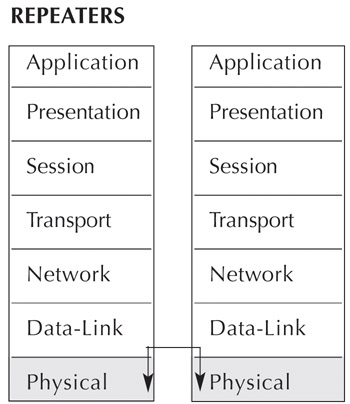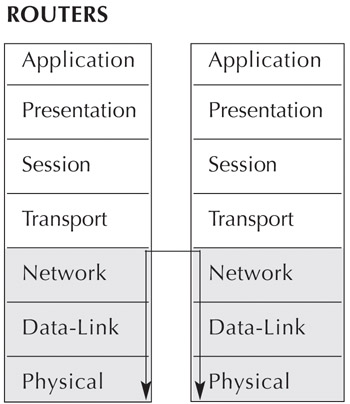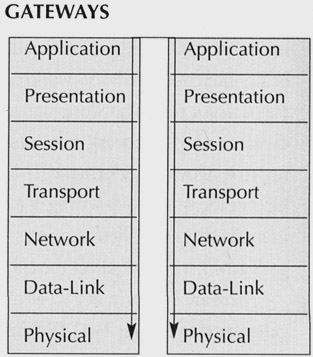Section VIII: Internetworking
| |
Internetworking
As local area networks become more and more prevalent and increasingly vital to the daily operation of an organization, the need to connect multiple LANs together has become as crucial as it once was to link individual PCs into a workgroup. More and more, it's likely that a worker linked into a firm's marketing department workgroup requires access to resources located on another LAN within the companya database in the engineering network, for example.
This need has spawned one of the fastest growing areas of the LAN industry: The internetworking marketplace , composed principally of repeaters, bridges, routers, gateways, and, most recently, hybrid products called brouters and routing bridges. Internetworking products bring interconnectivity to workers linked into large, spread-out groups of LANs. They also play a major role in network management by allowing network administrators to segment, or divide, a single network into an assembly of multiple subnetworks. This subdivision can improve network performancelimiting the number of nodes on a network can reduce traffic over the workgroup wiring. It also facilitates securityinternetworking allows restricting individuals to specified resourcesand increases system reliabilitywhen one workgroup goes down, it doesn't affect the entire network.
There are four primary types of internetworking products: repeaters, bridges, routers, and gateways (see Figures 14). (Beginning in 1994 or so, multiport bridges began to be marketed as switches, but switches usually provide the same fundamental functions as the devices traditionally known as bridges. In some cases, switches actually perform local routing functions as well.) Each internetwork product permits various levels of communication between individual networks; each also functions at a separate level within the OSI model.

Figure 1: Repeaters operate at the lowest OSI layer. They regenerate electrical signals.

Figure 2: Bridges operate at the MAC sublayer and are capable of modest traffic control and network partitioning.

Figure 3: Routers operate at the network layer and are capable of stringent traffic control and network partitioning.

Figure 4: Gateways provide translations between two dissimilar computer systems, such as a PC_LAN and an SNA network.
Repeating The Obvious
Repeaters offer the simplest form of interconnectivity. They merely regenerate, or repeat data streams (in reality, electrical signals) between cable segments. In their purest form, repeaters physically extend a network; repeaters operate at the Physical layer of the OSI model. Repeaters, for example, allow extending Ethernet network cable segments from 1,000 feet to more than 5,000 feet. In addition, they provide a level of fault tolerance by isolating networks electrically, so a problem on one cable segment does not affect other segments.
Repeaters do not allow a network manager to isolate traffic; they regenerate every data frame or jam signal over all the networks they link. They do nothing to relieve the load on a network's bandwidth.
Bridges, on the other hand, isolate traffic to specific workgroups while still offering the ability to connect multiple LAN cable segments into a large logical network. Bridges operate one layer higher than repeaters in the OSI model; they operate at the MAC sublayer of the Data-link layer.
Filtering Traffic
Most bridges operate only between similar LAN technologiesbetween two Ethernets or two Token Rings, for example but some do offer cross-technology capabilities. They regulate traffic by filtering data frames based on the destination address. When a frame's destination address is local, it is not forwarded by the bridge. When the destination address is remotei.e., to a node on another workgroupthe bridge forwards it. Bridges automatically "learn" the addresses of the devices attached to their subnetwork.
More sophisticated bridges allow filtering traffic on a variety of factors, including frame size , source address, and type of protocol. Because filtering reduces network traffic, it can substantially increase overall network performance. Bridges operate independently of the upper-layer protocols which allows them to handle any transport protocol, such as the TCP/IP, IBM's SNA, and NetBIOS.
Bridges use custom filters to selectively reject or forward frames that match administrator-specified conditions, such as frame size, specific transport protocol (XNS, TCP/IP), or destination address. Custom filters can work on frames whether they're flowing into or out of a network; a filter can also forward only those frames that match user -defined criteria.
System administrators can use custom filters to help set up and manage administrative domains within a network; for example, a network manager could develop custom filters that isolate electronic mail domains. Custom filters can also restrict protocol-specific frames to certain preset domains. Similarly, filters could forward only specified types of frames.
Source-explicit forwarding (SEF) gives administrator-defined workstations exclusive frame-forwarding privileges on the internetwork. Designated stations can forward frames through a particular port on a routing bridge, while the frames of stations without SEF rights will be rejected. SEF thus permits a system administrator to limit access to normally secure or isolated network segments or resources.
These types of controls let network administrators manage their LANs better, permitting them to create secure domains and increase inter-workgroup efficiency.
Traditional bridges have offered transmission capabilities from only a single workgroup to another workgroup, but the move to centralized LAN management centers has prompted LAN manufacturers to market multiport bridges, now commonly called switches. Multiport bridges give network administrators the advantages of modular expansion and/or reconfiguration. By replacing one interface card with anotherfor example, adding an FDDI link to a modular multiport bridgethe administrator can keep up with an organization's changing network environment without completely rebuilding the network infrastructure.
The Router Route
Routers operate at still another layer upat the network layer in the OSI reference model. Routers connect logically separate networks operating under the same transport protocol (i.e., TCP/IP or SNA). Routers are thus protocol-dependent and must support the individual protocols being routed. A router allows multiple paths to exist in an enterprise-wide network, and is " intelligent " enough to determine the most efficient path to send a particular data frame through those multiple paths.
In a typical enterprise-wide network divided by routers, the separate networks are assigned unique numbers , and each independent network is managed separately. Routers automatically learn changes in a network's configuration, just as bridges do, within the limitation of the network protocol's ability to pass routing information between routing nodes. Routers are more complex than bridges, however, because the scope and scale of the internetwork are typically much greater than those of bridged environments.
Routers are particularly useful in organizations with multiple large networks connected to a single backbone. Because they have an inherently more difficult task, routers are generally slower than bridges. Newer routers, capable of routing packets at a LAN protocol's maximum bandwidth (with 10Mbit/sec Ethernet, about 15,000 frames per second), are erasing this limitation, however.
The Spanning Tree Algorithm
The spanning-tree algorithm allows physical loops to exist in a bridged Ethernet network. Loops , which are formed when there are multiple data paths between two segments of an Ethernet network, are particularly useful in mission-critical networks because they provide fault-tolerant redundancy and permit internetwork devices to find and use the most efficient routes between the other internetwork devices on that enterprise-wide LAN.
In a large multi-loop Ethernet, the spanning tree algorithm determines the most desirable path between segments and disables all other paths to eliminate redundant loops. (This path selection process is governed by options that can be selected by the system administrator.) Then, when the active path is unusable for any reason, spanning tree automatically reconfigures the network, activating the most desirable alternative path, until the original active loop is brought back online. Spanning tree permits connecting a corporate network to subsidiary networks via high-speed "active" lines; should either active line fail, a backup loop would be brought online automatically, thus ensuring continued communications.
Spanning Tree's ability to automatically sense trouble areas allows organizations to build large, reliable networks that are still easily managed from a central site; managing similar topologies created with routers alone requires a staff of competent network management personnel.
The Gateway
Gateways act as translators between networks using incompatible transport protocols, such as between TCP/IP and SNA or between SNA and X.25. Gateways operate at the application layer of the OSI model.
One of the more common gateways is a communications gateway between a local area network and a mainframe or minicomputer; such a gateway generally places a special-purpose adapter card in a PC along with a standard network interface card. The resultant system serves as a shared gateway to the host for all the other PCs on the LAN. Such a gateway allows you to use a mainframe or mini as a network server, if desired.
The new internetworking products and features available combined with the old permit creating faster, more secure, and more cost-effective enterprise-wide networksthe kind now being demanded by multinational corporations.
This tutorial, number 21, was originally published in the April 1990 issue of LAN Magazine/Network Magazine.
| |
EAN: 2147483647
Pages: 193
- Enterprise Application Integration: New Solutions for a Solved Problem or a Challenging Research Field?
- Data Mining for Business Process Reengineering
- Intrinsic and Contextual Data Quality: The Effect of Media and Personal Involvement
- Healthcare Information: From Administrative to Practice Databases
- Relevance and Micro-Relevance for the Professional as Determinants of IT-Diffusion and IT-Use in Healthcare